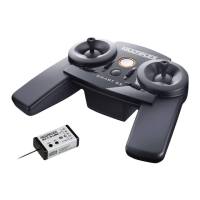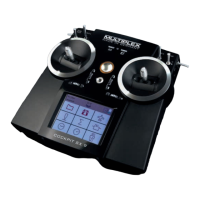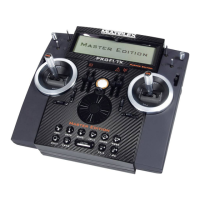Manual
37
This is the procedure for setting maximum servo
travel (control surface deflection):
Tip: first adjust the mechanical linkage
Always adjust the mechanical linkages on the model
as accurately as you can before you carry out any
(electronic) adjustments at the transmitter:
Fit the output arm on the servo output shaft at right-
angles to the line of the pushrod. This eliminates
any mechanical differential.
At the servo:
Connect the pushrod as close to the centre as pos-
sible, and set maximum servo travel. This reduces
the effect of play in the gearbox, and exploits the
servo’s torque to the full.
At the control surface:
Connect the pushrod as far out as possible on the
horn. This reduces the effect of play in the linkage,
and transmits the servo’s power to the control sur-
face in the most efficient way possible.
a. Open the main menu ¤Servo
(press button ¤).
b. Open the menu Calibrate and select the servo.
c. Select line P1 and open Parameter:
¤Calibr.AILERON+
¨Exit
á
0
P1
-100
%
P2 ---
P3 0%
P4 ---
P5 100%
d. Allocating “maximum” using button F
Now press button F. This generates the largest
possible value - the maximum - for all servos which
share the same basic function (or mixed function),
enabling you to set the maximum servo travel (control
surface deflection) regardless of the position of the
transmitter control, trims and any transmitter control
and mixer settings.
Note: moving the stick or pressing button F again
cancels this allocation!
Now test the function by operating the servo using
the associated stick. To re-allocate simply press
button F again.
e. Conclude the calibration process for P1
(press the 3-D digi-adjuster or the ENTER button).
! Note regarding “allocation”
Allocating the maximum in this way saves you the
bother of holding the stick at one end-point, and en-
ables you to use both hands in order to measure the
control surface deflection on the model. If necessary
you can make corrections using the 3-D digi-adjuster.
Calibrating multiple servos with the same function
Example: setting up the left and right ailerons
Servos 1 and 5 are assigned as AILERON+ (mixed
function). In the Calibration menu (Calibrate) you
open point P1 for servo 1. If you now press button F
to allocate maximum, both ailerons will immediately
take up the same end-point (e.g. up-travel). At this
point you can conveniently measure the control sur-
face deflection for servo 1 and adjust it using the 3-D
digi-adjuster, or alter it to match the travel of the ai-
leron on the other wing.
! Note: maximum servo travel = ±110%
If necessary you can increase servo travel on both
sides up to the maximum of 110%.
f. Repeat the procedure for point P5 starting at step c.
(if you have selected a five-point curve for the
servo concerned, you can also adjust P2 and P4
using the same method).
g. Quit the menu via ¨Exit, and adjust the remaining
servos in the same manner.
12.5. Adjusting ailerons, and activating
landing aid
(Mixer AILERON+)
This is the procedure for defining the mixer
AILERON+:
If you have not yet changed anything in the mixer
definition, the AILERON+ mixer is defined as follows:
5
1
Further servos
if required
Fig. 12.5.1.: The AILERON+ mixer in principle
The two aileron servos are controlled by the trans-
mitter controls Aileron, Spoiler, Flap and Elevator
without trim.
The mixer input Ele -Tr (Elevator without trim) is only
required for the “SnapFlap” function (elevator to ai-
leron mixer), and is selected using switch “G”. The “-”
following the G means that the switch is in the OFF
position.

